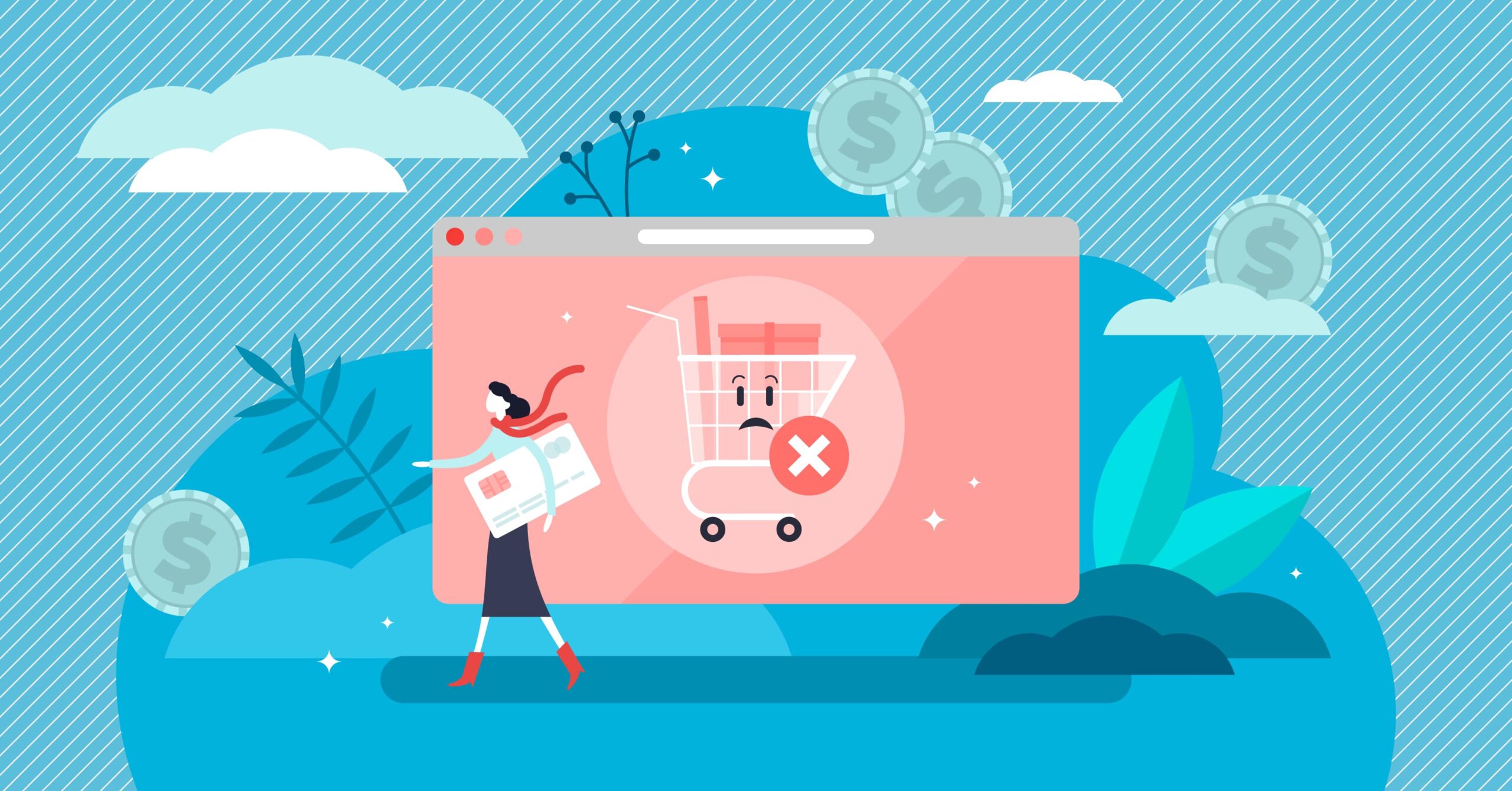Abandoned cart email flows target website visitors who have signaled high purchase intent and even shown you the products that interest them by placing those items in their cart. The potential return for abandoned cart campaigns makes these flows among the first you should develop and automate. Discover which abandoned cart templates to build and what content they should include to maximize your performance in this article.
Online businesses lose billions of dollars in potential revenue to abandoned carts each year. To prevent these losses, an abandoned cart campaign should be among your top priorities when setting up your business’s automated email flows.
Along with welcome and onboarding flows, abandoned email cart campaigns are critical to converting people from leads to customers, and from customers to repeat customers.
What is cart abandonment and how is it different from checkout abandonment?
Cart abandonment occurs when someone visits your website and places products or services in a digital shopping cart but doesn’t finalize their purchase. We use how far the shopper progressed toward finishing their purchase to distinguish between cart and checkout abandonment.
Someone who drops out of your sales funnel after putting an item in their virtual cart but before initiating the checkout process has abandoned their cart. If the dropout occurs after they have selected “checkout now” or a similar action, it is a checkout abandonment.
The reasons why someone abandons their cart before completing their purchase varies. Some people drop out of the purchase process because of disinterest–they weren’t really committed to buying. Others leave because of doubts about their decision or the cost of their purchase, or a negative interaction with your brand or its website.
Unexpected fees or high shipping costs, unattractive return policies and even too many fields to complete at checkout can cause an engaged shopper to disengage.
Knowing exactly where someone has exited the path to purchase will help you pinpoint the reasons they abandoned your funnel and develop and select the best abandoned cart templates to bring them back.
Recovering the shoppers that got away presents a huge opportunity for growth for online businesses with limited or no downside.
People who place items in a digital shopping basket are already aware of your business and interested in the products or services you’re selling. They’ve invested time to evaluate different choices on your website and make specific selections. These shoppers have also provided you with valuable first-party data you can use to tailor your recovery messages.
By the time someone reaches the ‘place in cart’ stage of your funnel, much of your customer acquisition costs have already been assumed. Capturing these sales comes at little additional expense.
Ready to get those gains? Keep reading.
What do you need to build an effective abandoned cart series?
First, you’ll need a means of identifying your cart abandoners and their email addresses. Capturing your website visitors’ email addresses and being able to recognize repeat visitors is essential to make your abandoned cart campaigns work.
Next, you’ll need to create your recovery flows. Your abandoned cart campaigns should be a series–not just a single message. You’ll create your abandoned cart drips by building a set of abandoned cart recovery templates and setting the behavior-based triggers that activate them.
Before you can prepare your abandoned cart flows, you need to create a map of how you anticipate those flows will progress.
- How many abandoned cart emails will you send?
- What levers will you use to influence buyers to complete their purchases?
- When will you end or divert a recovery drip?
Finally, you’ll need to connect your website and contact data with your email marketing platform so that your templates can be customized and the process of sending these campaigns is fully automatic.
Now, let’s dig into the details of how many abandoned cart templates you’ll need and what you should put in them.
How many abandoned cart email templates should your flow have?
The number of emails to your abandoned cart campaigns depends on your available resources, campaign objectives and the campaign’s ultimate performance. Use information about your audience segments, past performance, and cost versus benefits analysis to identify the best abandoned cart strategies for your business.
Prepare a minimum of three abandoned cart email templates for your first drip campaign. A typical 3-stage recovery series begins with a reminder message, followed by an incentive offer and finally, a last chance or cart expiration warning.
As your cart recovery program matures, expand this 3-template set with additional emails that enable branching and extended campaigns. (Make sure your flows include termination triggers that prevent someone from continuing to receive the series after they’ve clicked through and completed their purchase.)
In a longer abandoned cart series, you can use a flash sale as your first incentive and try a different offer in a later message. Discounts and similar incentives aren’t your only options for your extended campaigns, either.
A multi-template abandoned cart flow offers opportunities to employ social proof and other means to overcome objections and present product recommendations that may win your brand a sale–even if it isn’t a sale of the original cart’s contents.
Continue to test and collect data about various abandoned cart campaigns to determine the ideal number of abandoned cart emails to send, as well as the content and timing of each.
Do you see a loss of engagement, a drop in deliverability or an uptick in unsubscribes after sending five or six recovery emails?
What is the click-through a conversion rate and revenue per email for each message in the series?
Monitor your email marketing KPIs for signs that the costs of sending your recovery emails are outweighing the gains. Be sure to consider the costs of developing and sending your campaigns and any negative consequences such as unsubscribes or spam complaints.
Three-stage abandoned cart email sequence template set
Below is an example of a three part abandoned cart series with suggested sending times and a description of the type of content it might include.
First email: A reminder message
Within one to four hours after someone has placed an item in their cart and left your website, you’ll typically send the first email in your abandoned cart campaign. Many experts recommend sending a simple, friendly reminder as your first communication and saving any discounts or other incentives for later.
Holding off on discount offers improves the net revenue you’ll gain if your email campaign succeeds. But, of course, it comes with the risk that there will be no sale and no revenue without the leverage of an incentive.
As an alternative to offering a specific recovery incentive, use your reminder email to explain existing sales incentives such an ‘available to everyone’ free shipping offer.
Second email: A special win back offer
Between 12 and 24 hours after the cart reminder email, it is time to follow up. At this point you’ll need to decide whether to offer special incentive to capture this sale or use other persuasive devices.
You may wish to split your abandoned cart list segment into high-potential and low-potential cart value segments and make a different offer to each group.
Third email: The last chance or your cart is expiring message
The third email in a three-stage abandoned cart series should inform the recipient that time is up. This template may include copy warning that the shopper’s special offer will soon expire or that their saved cart isn’t going to be saved anymore.
You’ll issue this third email in your cart recovery campaign 20 to 72 hours after the second message and four to six hours before the offer or cart actually expires.
As with the other emails in your series, you have options about what type of message you want to send in this final email.
If urgency isn’t the right lever for your brand or audience, use your third abandoned cart email to remind them of the benefits of purchasing from you, offer assistance, introduce social proof, offer a different incentive or extend the existing one.
Use these alternate content ideas to populate your other templates if you decide to retarget cart abandoners with a longer drip campaign.
Add in some of the other suggestions in the next section, too!
What content to include in your abandoned cart email templates
Abandoned cart emails employ a variety of levers or persuasive devices to recapture someone’s attention and entice them to complete their buyer’s journey.
How do you write abandoned cart emails that move all the right levers to convince your wandering buyers to return and place their orders when you don’t always know a specific shopper’s motivation?
Most of your templates will use more than one type of content and persuasive device or appeal. Some are common elements you’ll want to include in one or more of your abandoned cart email templates and others that are optional.
As part of your development process, you will need to test different combinations and send times to identify the tactics that work best with each of your audience segments. Buyers who abandon their path for different reasons may need different messaging to recover.
For example, a limited-time offer or a humorous reminder that puts them in a good mood might win an impulse purchaser back. An analytical buyer is more likely to be moved by informational content and proof of value.
9 types of content to include in abandoned cart email templates (with examples)
1. Content that refreshes your shopper’s memory. Remind the email recipient that they visited your site and found something they liked. Do this by saying it with words and pictures.
Add a dynamic block to your abandoned cart email template that draws data directly from your website and displays the products (or lists the services) the targeted recipient selected.
📧 Five Below keeps the message simple in this abandoned cart reminder.
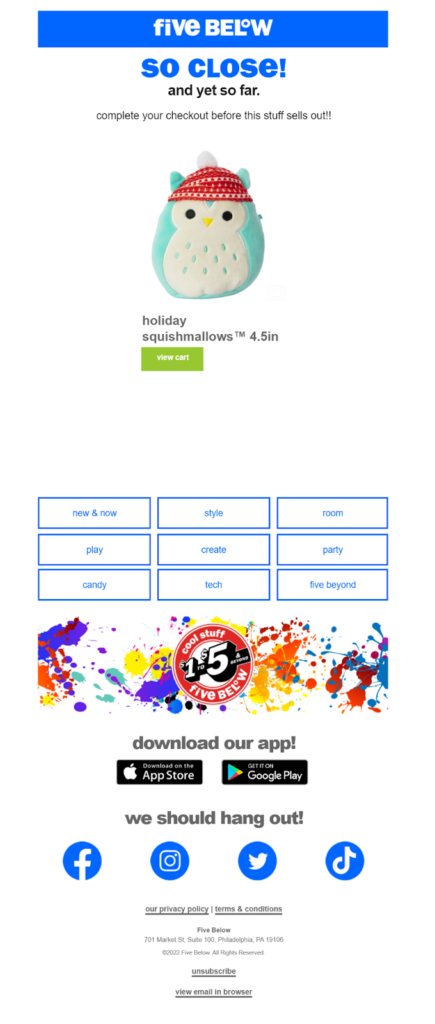
📨 Your items are waiting for you – you have chosen wisely.
Novelty retailer Five Below uses a streamlined template to send customized reminders to customers who added to cart but didn’t check out. The dynamic product image and “View Cart” CTA button are the heroes of this email.
Like some of the other abandoned cart email examples I’ve shared, this template doesn’t change much from send to send. The brand mixes its abandoned cart messaging up by swapping between several subject line and preview text combinations.
2. Information that overcomes doubts about the transaction. Tell email recipients about your shipping and return policies, and your product or service guarantees. Use trust signals and social proof to add credibility to your message. Also include links to your FAQ pages.
📧 Peet’s Coffee sends an abandoned cart email that invites interaction with a product finder quiz.
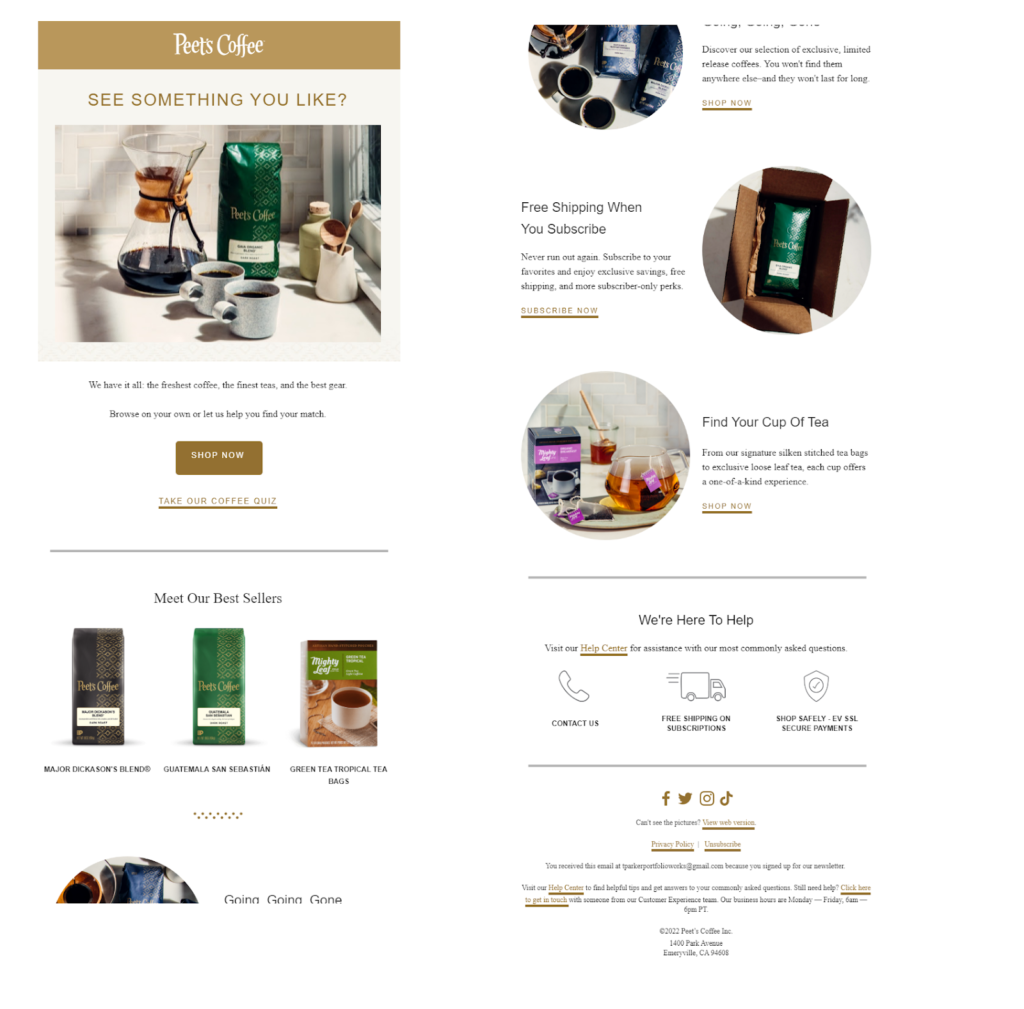
📨 Pondering a purchase? – There’s a brew waiting for you.
The header on this template asks recipients if they “See something they like?” before displaying a shopped item. Then the message invites the recipient to continue browsing or click through to “take our coffee quiz” to find their flavor match.
The email presents other products and offers before ending with a “We’re here to help” panel that includes links to the brand’s help center and contact page.
3. Financial incentives such as discounts or free gifts. Make your high-value shoppers an offer too good to pass up to move them toward deciding. Use discounts that make financial sense to you and your buyers. If you have excess inventory, try a ‘buy one, get one’ offer. If you’d rather offer future savings, use reward bucks or a discount on their next purchase.
Of course, a straight percentage discount on the items in a shopper’s cart is always an option, too.
📧 If cost is the problem, candy maker Licorice has the solution.
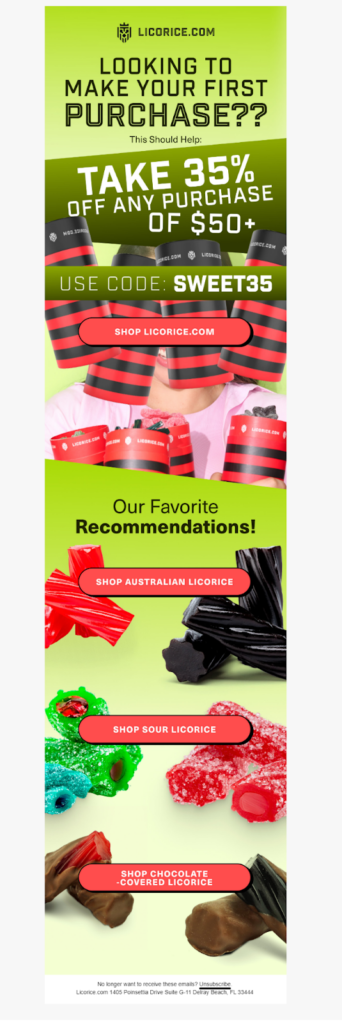
📨 Would this help?
This recovery email from Licorice targets not yet customers, encouraging them to make their first purchase with a generous 35% off code. The copy uses a friendly tone, saying “Looking to make your first purchase?? This should help.”
The email doesn’t include dynamic content of the shopper’s selections. Instead, it includes a selection of recommended products. Businesses can add product recommendations to email messages using static selections or insert customized content chosen by a product recommendation engine.
4. Offers and incentives that increase the perceived value of your product or service. This content may include benefits offered exclusively to your targeted shopper or more general incentives or value-adding features.
Examples of added-value content include explanations of your business’s VIP or rewards point program, buy now pay later options, personal shoppers or similar benefits.
📧 Cookware brand Our Place highlights the reasons to say yes in its abandoned cart message.

📨 Still deciding? Don’t forget you can save BIG on this sale!
Our Place presents undecided shoppers with a list of reasons to click ‘buy now’ in an abandoned cart message that asks, “Still deciding?”
The top of this template features details of the brand’s current sale, its Black Friday sale in this case. Dynamic content comes in the form of a product image over a button CTA that says, “Take another look.”
Following this customized section, the template returns to content about the Black Friday sale before transitioning to a section standard designed to overcome objections.
Under the heading, “Reasons to shop Our Place,” are graphics and text highlighting the brand’s free shipping, returns and exchange policy, pay later option and rewards program.
Finally, there’s a separate panel pointing recipients to a customer service email address where they can send their questions.
5. Values statements and social or community engagement. Not every benefit to shopping with your brand is financial. Eighty-two percent of consumers prefer businesses that share their values. Include information about your brand community, share user generated content and explain your business’s commitment to sustainability and other issues that matter to your audience.
📧 Humanizing humor and shared values frame Snarky Tea’s abandoned cart message.
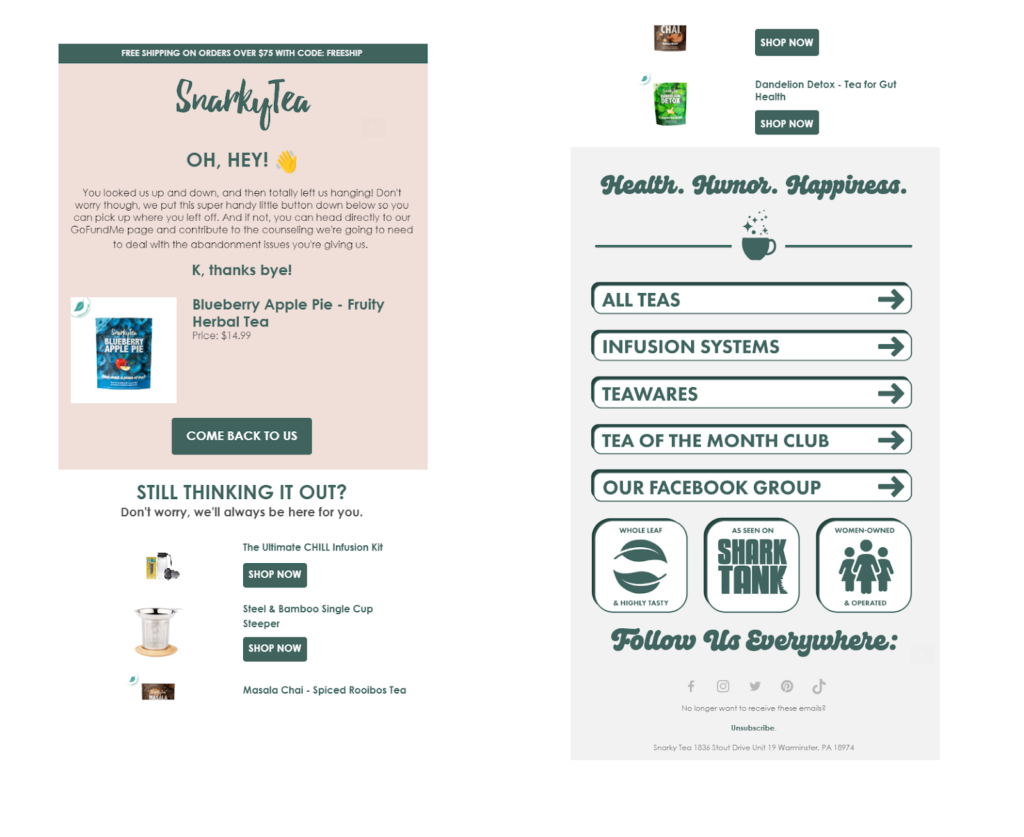
📨 Are we being weird? 😳 – So we totes know you checked us out…
Snarky Tea’s abandoned cart message doesn’t offer recipients a discount for completing their purchase. Instead, the offbeat brand uses humor to engage shoppers along with images of the abandoned product and other recommendations based on the person’s browsing history.
The copy for this template says,
“Oh, hey!
You looked us up and down, and then totally left us hanging. Don’t worry though, we put this super handy little button down below so you can pick up where you left off…”
That handy button is a CTA that says, “Come back to us.”
A second headline and sub-headline above the browse-based recommendations say,
“Still thinking it out? Don’t worry, we’ll always be here for you.”
The product images and details for this cart recovery email are inserted into the template using dynamic codes while the rest of this email is static. At the bottom of the email, Snarky Tea shares its values and philosophy and invites subscribers to join the brand’s community on social media.
💡 Don’t forget who you are or who your customers are when creating your cart recovery templates. Use buyer personas to help your team keep your audience top of mind during the development process.
6. Offers of assistance. Recover shoppers who still have doubts by offering to connect them with your customer service team. Express your willingness to work with your customer to help them find the perfect item and resolve any lingering questions.
📧 Amish Baskets uses a template that combines an offer of help with dynamic product images for its abandoned cart reminder.
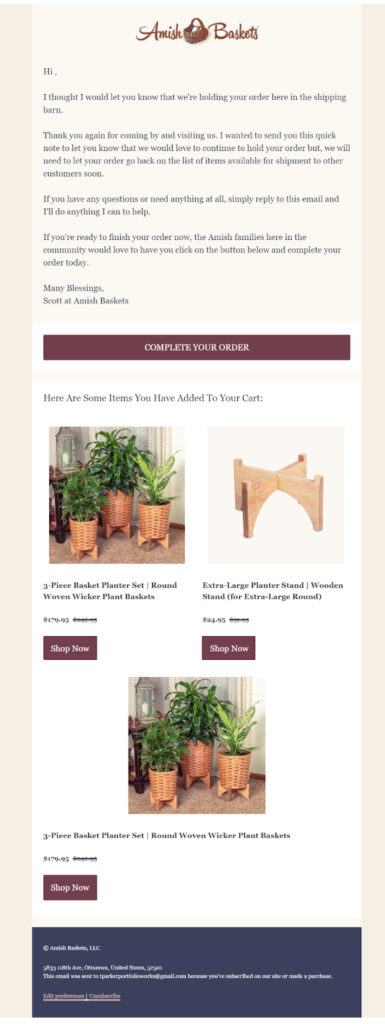
📨 Would You Like Us To Continue To Hold Your Order? – We’re holding your order here at the shipping barn.
7. Content that presses the FOMO button. Urgency, scarcity, and other fear of missing out inducing messages are a common theme in abandoned cart emails. These messages press consumers to decide. Adding countdown timers and other interactive elements can heighten the emotions these behavior-triggered last chance emails induce.
To counteract the negative feelings these messages may cause, pair your FOMO-mongering with a positive by offering an incentive such as double rewards points, free shipping or a free gift for shoppers who act.
📧 A warning that good things don’t last forever from Modern Citizen’s cart recovery campaign.

📨 Don’t let this piece get away 〰️ – One final look before it’s gone
Clothing maker Modern Citizen’s email copy continues its subject line’s theme– buy now before it’s too late.
“Almost Gone” is the email template’s heading. The brand then explains,
“Our collections are intentionally made in limited runs, and pieces sell out quickly. Don’t let it get away…”
Adding to the sense of urgency is a CTA button that says, “Check Availability.”
Ouch! They aren’t messing around.
All is not lost though, if the shopper misses out on their selected item, they can shop the catalog or choose one of the pieces recommended in the email.
8. Alternative product recommendations. Okay, maybe your shopper didn’t finalize their purchase because they liked your product or service, but something wasn’t quite right. Save the sale by including alternative suggestions in your abandoned cart email series.
Start with focused recommendations that point to similar items based on your recipient’s behavior. If you still don’t get the sale, try a broader recommendation set that includes products for the same or even related categories.
This strategy helps you maintain engagement with a person who has exhibited an interest in your product or service and may set the stage for future sales.
📧 Kidrobot sends personalized reminder messages with a hint of scarcity and some “you might also like” recommendations.
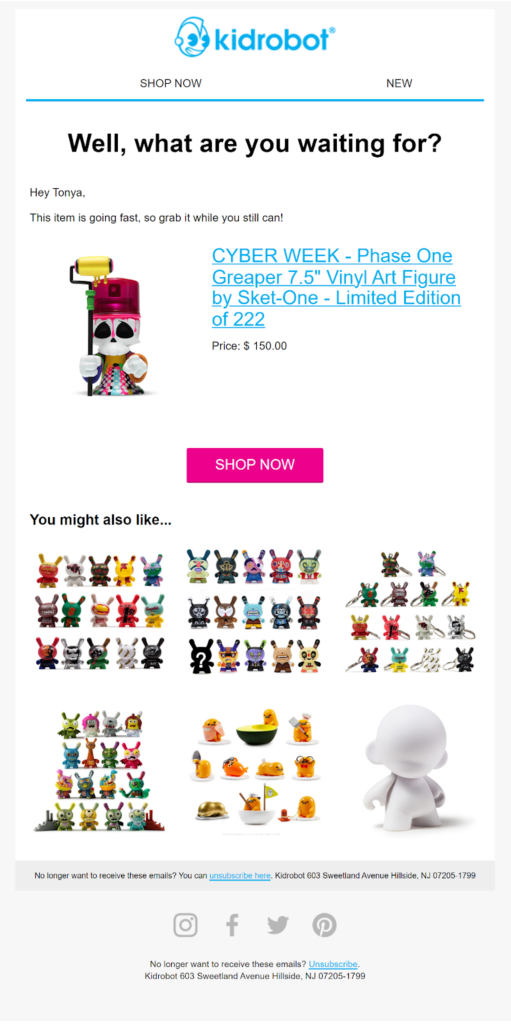
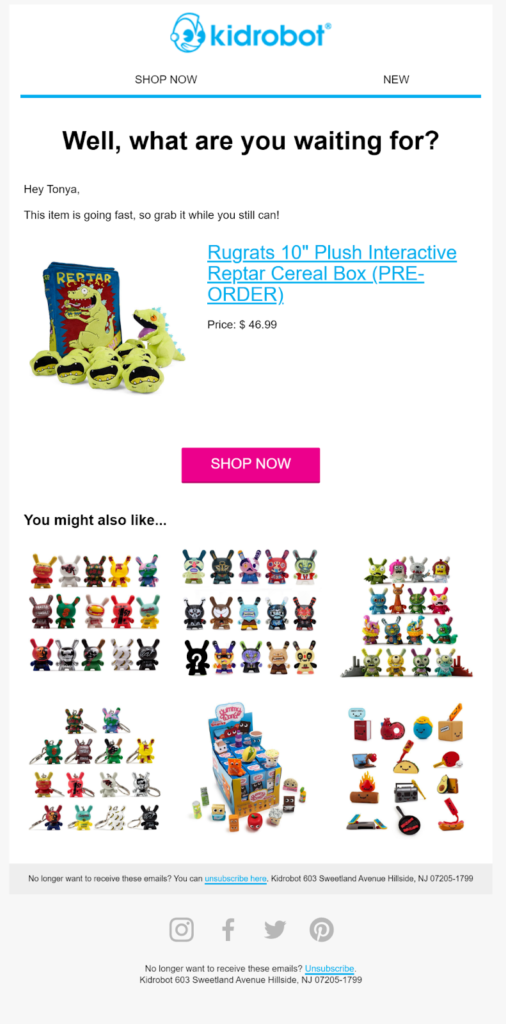
📨 Did you see something you liked?
Kidrobot’s abandoned cart reminder template is built using standard header, footer and copy. To stimulate a little urgency, the copy notes, “This item is going fast, so grab it while you still can!”
Each message is then customized with a dynamic field that inserts the recipient’s name and a dynamic block displaying an image of the cart contents along with pricing details. Creating templates with HTML code that fetches content from your data sources is the key to sending personalized, automated emails at scale.
A side-by-side comparison of the two abandoned cart messages above reveals that the product recommendation section of this template is dynamic, too.
9. Indirect references to the shopper’s activity. Sometimes you can recover a missed sale without saying anything about the person’s cart in your abandoned cart email.
All you have to do is send them a message that triggers their memory. “Oh yeah, I was looking for a new rug last week. Maybe I should check back and see what’s on sale at this store.”
These indirect abandoned cart emails work similarly to a broad product recommendation and increase your chances of drawing a lapsed shopper back to your site.
📧 Kirkland’s focuses its message on what’s in it for the shopper with cart recovery inbox copy that doesn’t mention the cart.
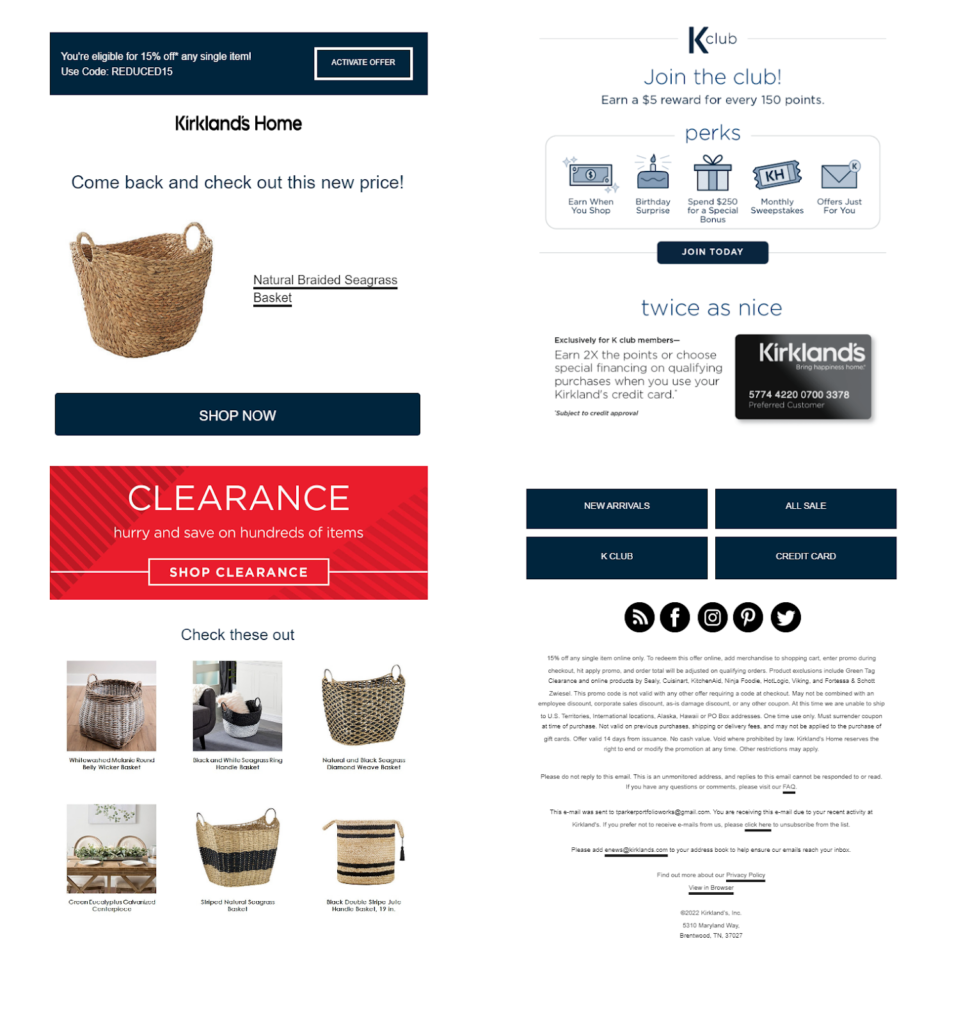
📨 💲Price drop! Natural Braided Seagrass Basket is now on sale… – Check out the new price and grab it today!
The subject line and preview text of this abandoned cart email don’t mention the shopper’s cart at all. But the copy is personalized, referencing the product in that cart.
Inside more dynamic content displays the left item and other suggested products.
Demonstrating how to combine multiple appeals, this email also includes a link to the home goods seller’s other clearance merchandise. This template includes space for a top banner bearing a discount code and above-the-footer content introducing the brand’s perks club and store credit card.
Give your abandoned cart email templates their best chance at success with subject lines and preview text that get clicks
You may have noticed that many of the abandoned cart email examples I share do much of their persuading in the subject line and preview text. Yours should, too. A great subject line can earn your business more engagement and revenue.
Check out our guide to abandoned cart email subject lines and preview texts for over 130 examples of copy you can use to get your cart recovery emails the attention they deserve. From funny to FOMO, we have a subject line to fit your message.
Then take your recovery game to the next level with cross-channel retargeting campaigns that use your email list data to reach and remind your customers wherever they are.

